
William Golding’s 1954 novel‚ Lord of the Flies‚ explores human nature‚ civilization‚ and savagery through British boys stranded on a deserted island‚ revealing inherent darkness.
Overview of the Novel
Lord of the Flies‚ published in 1954‚ is a dystopian novel by William Golding. It tells the story of British schoolboys stranded on a remote island after a plane crash. With no adult supervision‚ the boys attempt to govern themselves‚ initially striving to maintain order and civility. However‚ their society descends into chaos as primal instincts and power struggles emerge. The novel explores themes of civilization vs. savagery and the inherent evil within humanity‚ ultimately revealing the darker aspects of human nature when societal structures collapse.
Author Background: William Golding
William Golding (1911–1993) was a British novelist‚ playwright‚ and poet. Born in Cornwall‚ England‚ he studied natural sciences at Oxford University before becoming a teacher and later a naval officer during World War II. His experiences in the war profoundly influenced his writing‚ shaping his pessimistic view of human nature. Golding’s debut novel‚ Lord of the Flies‚ earned him widespread acclaim and a Nobel Prize in Literature in 1983. His works often explore the darker aspects of humanity‚ blending philosophical and moral themes.
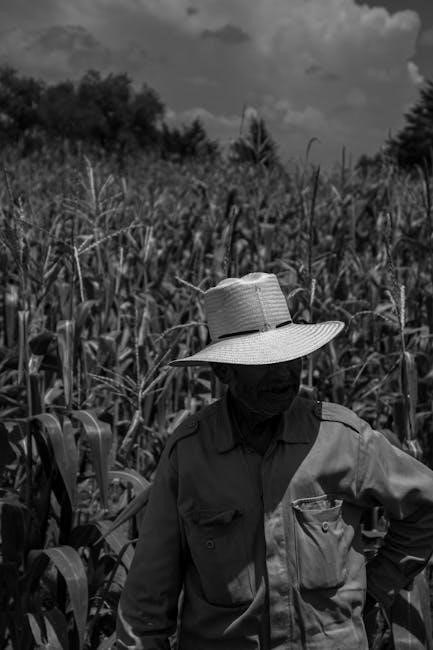
Key Themes in “Lord of the Flies”
The novel explores human nature’s darker aspects‚ societal structures‚ and moral decay‚ highlighting conflicts between civilization and savagery‚ power‚ and the inherent evil within humanity.
The Inherent Evil in Humanity
William Golding’s Lord of the Flies delves into the darker aspects of human nature‚ suggesting that evil is an inherent part of humanity‚ not an external force. The novel illustrates how‚ when stripped of societal constraints‚ individuals revert to primitive instincts‚ revealing a capacity for cruelty and violence. The boys’ descent into savagery‚ exemplified by their hunting rituals and the eventual murder of Simon‚ underscores Golding’s belief that evil is embedded within humans‚ emerging when civilized norms are abandoned. This theme is central to the novel’s exploration of human morality and behavior in crisis situations.
Civilization vs. Savagery
Lord of the Flies by William Golding explores the conflict between civilization and savagery through the story of boys stranded on an island. Initially‚ they attempt to create a civilized society‚ using tools like the conch shell to maintain order. However‚ as the novel progresses‚ their primal instincts dominate‚ leading to chaos and violence. The boys’ descent into savagery is marked by their obsession with hunting and fear of the “beast‚” symbolizing the fragile boundary between human civility and inherent barbarism. This theme reflects Golding’s view of humanity’s duality‚ emphasizing how quickly societal norms can erode without structure.
Power Dynamics and Leadership
In Lord of the Flies‚ power dynamics and leadership are central themes‚ as the boys’ struggle for control shapes their society. Ralph‚ elected as leader‚ represents democracy and order‚ while Jack’s authoritarianism and desire for power drive conflict. The conch shell symbolizes Ralph’s authority‚ but its influence wanes as fear and savagery grow. Jack’s rise to power through manipulation and fear highlights the dangers of unchecked ambition. Piggy‚ though intelligent‚ is marginalized‚ showing how leadership can be undermined by physical strength and charisma rather than intellect. This dynamic reflects Golding’s exploration of human nature and governance.
Religious Allegory and Symbolism
Lord of the Flies contains rich religious allegory‚ with symbols like the “beast” representing fear and the unknown‚ mirroring biblical notions of evil. The island itself symbolizes Eden‚ while the boys’ descent into chaos reflects the Fall of Man. Simon’s death‚ revealing the truth about the beast‚ parallels martyrdom‚ and the pig’s head‚ “Lord of the Flies‚” embodies Satan. Golding’s use of light and dark imagery further underscores moral and spiritual struggles‚ echoing Christian themes without direct religious parallels‚ making the novel a profound exploration of human morality.

PDF Availability and Formats
William Golding’s Lord of the Flies is widely available in PDF format‚ with files ranging from 799 KB to 1.9 MB. Platforms like LitRes offer downloads in PDF‚ EPUB‚ and TXT‚ ensuring accessibility for readers worldwide.
Downloading “Lord of the Flies” in PDF Format
Downloading Lord of the Flies in PDF format is straightforward‚ with various sources offering the book for free or purchase. Platforms like GitHub‚ online archives‚ and e-book services provide direct links to PDF files‚ ranging in size from 366 KB to 1.9 MB. Users can access the novel through websites such as LitRes or Scholar Annotation‚ ensuring easy readability on devices. This format is ideal for students and readers seeking a convenient way to explore Golding’s classic tale of human nature and survival.
Comparison of PDF with Other Formats (e.g.‚ EPUB‚ TXT)
PDF‚ EPUB‚ and TXT are popular formats for Lord of the Flies. PDFs maintain original formatting‚ ideal for study guides and structured reading. EPUBs offer reflowable text‚ suitable for e-readers and mobile devices. TXT files are lightweight but lack formatting‚ making them less visually appealing. PDFs are widely available on platforms like GitHub and LitRes‚ while EPUBs and TXT files are also accessible‚ catering to different reader preferences and device compatibility‚ ensuring the novel remains accessible in various digital formats.
Popular Platforms for Downloading the PDF
Several platforms offer Lord of the Flies in PDF format. LitRes provides the book in multiple formats‚ including PDF‚ while GitHub hosts downloadable PDF files for free. Additionally‚ platforms like Scribd and Google Drive often have user-shared PDFs. Online libraries and educational websites also offer PDF versions‚ making it easily accessible for readers worldwide. These platforms cater to different preferences‚ ensuring the novel remains widely available in digital formats for academic and personal use.
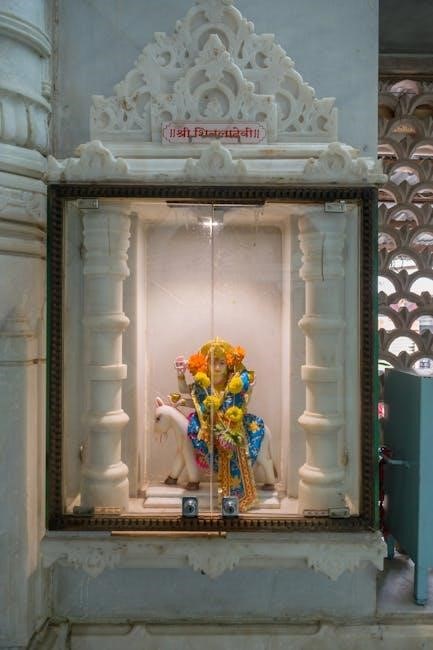
Analysis of Major Characters
Ralph embodies order and leadership‚ while Jack descends into savagery‚ and Piggy represents intellect and morality‚ showcasing the novel’s exploration of human nature and conflict.
Ralph: The Symbol of Order and Civilization
Ralph‚ the protagonist‚ represents order and civilization in Lord of the Flies. Elected as the leader‚ he embodies democracy and fairness‚ using the conch shell to maintain order. Ralph focuses on building shelters and keeping a signal fire‚ symbolizing practicality and responsibility. However‚ as the novel progresses‚ Ralph’s leadership is challenged‚ revealing his internal struggle between civility and primal instincts. His character highlights the tension between humanity’s capacity for order and its descent into chaos‚ making him a central figure in exploring Golding’s themes of human nature.
Jack Merridew: The Descent into Savagery
Jack Merridew evolves from a civilized choir leader to a symbol of savagery in Lord of the Flies. Initially‚ he supports Ralph’s leadership but soon becomes obsessed with hunting‚ seeking power and control. Jack’s descent is marked by his growing aggression‚ fear of the beast‚ and eventual formation of a tribal group. His obsession with killing pigs reflects his primal instincts‚ and his painted face symbolizes his complete embrace of savagery. Jack’s transformation highlights the erosion of civilization and the rise of primal human nature in the absence of societal constraints.
Piggy: The Voice of Reason and Intellect
Piggy‚ the intelligent and rational character in Lord of the Flies‚ embodies intellect and democracy. Despite his physical limitations‚ he relies on logic and the conch shell to advocate for order. His support for Ralph’s leadership contrasts with Jack’s descent into savagery. Piggy’s tragic death symbolizes the loss of reason and civility‚ highlighting the novel’s exploration of human nature and societal norms. His pragmatic ideas‚ like using the conch for meetings‚ underscore his crucial role in the group’s initial civilization.
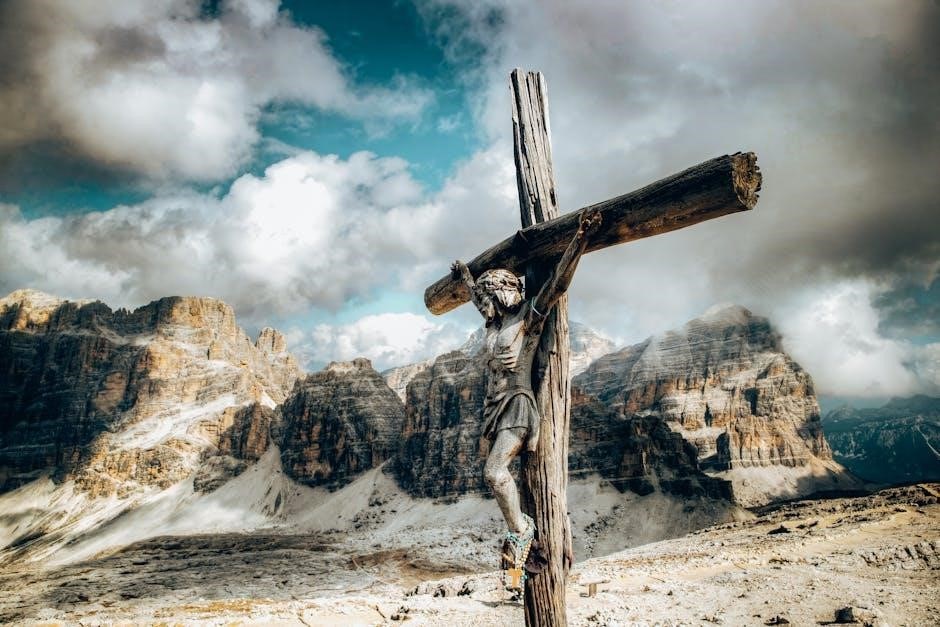
Symbols and Their Significance
In Lord of the Flies‚ symbols like the conch shell‚ beast‚ and Piggy’s glasses represent democracy‚ fear‚ and intellect. These elements highlight the novel’s exploration of human nature.
The Conch Shell: A Symbol of Democracy
The conch shell is a powerful symbol in Lord of the Flies‚ representing democracy and order. Found by Ralph‚ it is used to summon meetings and grant speaking rights‚ emphasizing equality; Its presence ensures civility‚ as boys must hold it to speak‚ maintaining decorum. However‚ its loss later in the novel signifies the erosion of democracy and the descent into savagery‚ highlighting the fragility of civilized structures. The conch shell thus serves as a poignant reminder of humanity’s capacity for both order and chaos.
The Beast: Fear and the Unknown
The Beast in Lord of the Flies symbolizes the primal fear of the unknown‚ deeply rooted in the boys’ psyche. Initially‚ it is believed to be a mysterious creature on the island‚ sparking paranoia and dread. The Beast becomes a shared obsession‚ driving the boys to adopt savage practices to ward it off. However‚ it is later revealed to be a dead pilot‚ symbolizing the true horror: not an external monster‚ but the darkness within themselves. This fear escalates tensions and accelerates their descent into chaos‚ highlighting the destructive power of irrational terror.
The Lord of the Flies: The Embodiment of Evil
The Lord of the Flies‚ a pig’s head impaled on a stake‚ symbolizes the embodiment of evil and corruption. It represents the primal savagery and darkness within humanity‚ as revealed through Jack’s ritualistic act. The pig’s head‚ infested with flies‚ signifies decay and moral corruption. Simon’s encounter with it reveals the beast as a manifestation of human nature’s inherent evil‚ not an external entity. This symbol underscores the novel’s exploration of humanity’s capacity for cruelty and the loss of innocence‚ central to Golding’s philosophical themes.
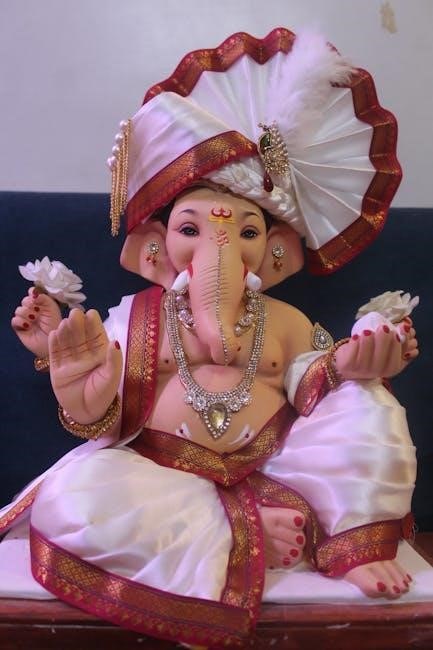
Historical Context
Lord of the Flies reflects William Golding’s experiences in World War II‚ exploring how crisis reveals humanity’s darker instincts‚ echoing the chaos of global conflict.
Golding’s Inspiration from World War II
William Golding drew inspiration from his experiences in World War II‚ where he witnessed the collapse of societal norms and the rise of primal instincts. The novel mirrors the chaos of global conflict‚ reflecting how humanity’s inherent darkness emerges under stress. Golding’s service in the Royal Navy exposed him to the harsh realities of war‚ influencing his portrayal of the boys’ descent into savagery. This historical backdrop underscores the novel’s exploration of human nature‚ linking it to the broader context of wartime atrocities and societal breakdown.
The Influence of Human Nature in Crisis
William Golding’s Lord of the Flies reflects how human nature unravelles in crises‚ as seen through the boys’ descent into chaos on a deserted island. The novel highlights how societal norms collapse under stress‚ revealing primal instincts. Golding’s exploration of fear‚ power struggles‚ and moral decay mirrors real-world crises‚ such as wars‚ where humanity’s darker tendencies emerge. This theme underscores the universal relevance of the novel‚ offering a timeless commentary on human behavior when civilisation crumbles. The boys’ actions serve as a microcosm for broader societal breakdowns‚ emphasizing the fragility of order and ethics in dire situations.

Moral and Philosophical Themes
The novel explores inherent human evil‚ moral decay‚ and ethical dilemmas‚ prompting reflections on society’s values and the nature of good vs. evil.
The Nature of Humanity: Good vs. Evil
Lord of the Flies delves into the duality of human nature‚ illustrating how innocence and morality deteriorate when societal constraints are removed. The novel symbolizes the internal struggle between good and evil through the boys’ actions‚ revealing that savagery is an inherent part of humanity. The conch shell‚ representing order‚ contrasts with the beast‚ embodying fear and chaos. Golding suggests that without civilization‚ humans revert to primal instincts‚ highlighting the thin line between righteousness and wickedness‚ and questioning whether humanity is inherently good or evil by nature.
The Role of Ethics in Society
Lord of the Flies examines how ethics are shaped and maintained within societal structures. The novel highlights the importance of rules‚ accountability‚ and collective moral agreements to uphold ethical behavior. Through the boys’ descent into chaos‚ Golding illustrates that ethics are not innate but are sustained by civilization. The conch shell‚ symbolizing democracy‚ represents the fragile framework that maintains order and justice. Without such structures‚ individuals succumb to self-interest and primal instincts‚ revealing how ethics rely on societal norms and the presence of accountability to survive and thrive.
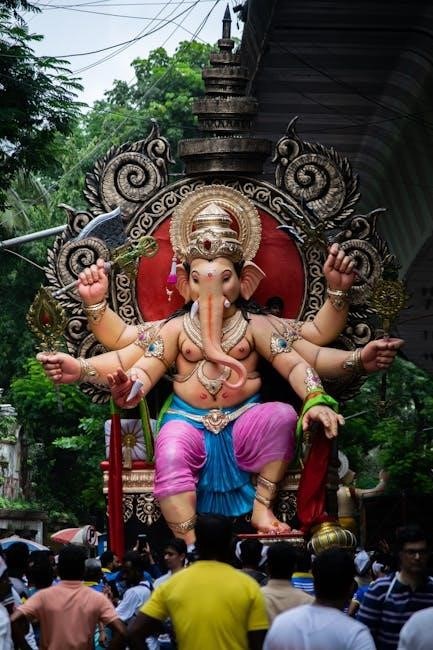
Modern Perspectives and Relevance
Lord of the Flies remains a timeless commentary on human nature‚ resonating with contemporary debates on societal structures‚ morality‚ and the duality of civilization versus savagery.
The Novel’s Relevance in Contemporary Society
Lord of the Flies remains a powerful allegory for modern society‚ exploring themes of power‚ fear‚ and morality that are timeless. Its depiction of human nature’s darker aspects resonates with contemporary issues like political polarization‚ social inequality‚ and the breakdown of civility. The novel’s examination of how quickly societal norms can crumble mirrors concerns about global instability and leadership crises. Additionally‚ its availability in PDF and other digital formats ensures its accessibility for new generations‚ making it a vital resource for understanding human behavior in today’s world.
Adaptations and Interpretations
Lord of the Flies has inspired various adaptations‚ including films‚ stage plays‚ and reinterpretations‚ each offering unique perspectives on its themes. The 1990 film adaptation‚ for instance‚ brought the novel’s raw intensity to the screen‚ while a planned all-female remake sparked debates about gender dynamics in the story. These interpretations highlight the novel’s versatility and enduring relevance. Additionally‚ the availability of PDF versions has facilitated widespread analysis and discussion‚ making it easier for readers to engage with Golding’s exploration of human nature and societal collapse.

Study Guides and Educational Resources
PDF study guides for Lord of the Flies offer in-depth analysis of themes‚ characters‚ and symbolism‚ aiding students in understanding Golding’s exploration of human nature and society.
PDF Study Guides for “Lord of the Flies”
PDF study guides for Lord of the Flies provide comprehensive analysis‚ including themes‚ characters‚ and symbolism. These resources are available on platforms like GitHub and LitRes‚ offering insights into Golding’s exploration of human nature. The guides often include chapter summaries‚ discussion questions‚ and critical essays‚ making them invaluable for students and educators. Some PDFs also feature annotations and study tips‚ helping readers deepen their understanding of the novel’s moral and philosophical themes. They are easily accessible and compatible with various devices‚ enhancing learning flexibility.
Online Resources for Analysis and Discussion
Online resources for Lord of the Flies offer extensive analysis and discussion tools. Websites like LitRes and GitHub provide downloadable PDFs with detailed study guides‚ while platforms like Google Scholar host critical essays and annotations. Online forums and educational databases feature discussions on themes‚ characters‚ and symbolism‚ aiding deeper understanding. These resources are invaluable for students and educators‚ offering insights into Golding’s exploration of human nature‚ civilization‚ and morality‚ and fostering engaging academic conversations about the novel’s timeless relevance.
Lord of the Flies remains a timeless exploration of human nature‚ morality‚ and civilization. Its enduring relevance ensures continued discussion and analysis‚ with PDF formats making it easily accessible for readers worldwide.
Final Thoughts on the Novel’s Impact
Lord of the Flies is a profound exploration of human nature‚ challenging readers to reflect on morality‚ civilization‚ and inherent evil. Its timeless themes resonate across generations‚ making it a cornerstone of literary studies. The novel’s ability to provoke thought about society’s fragility ensures its relevance in contemporary discussions. Available in PDF formats‚ it remains accessible for readers worldwide‚ solidifying its place as a classic. Golding’s work continues to inspire reflection on ethics‚ leadership‚ and the duality of human behavior‚ leaving a lasting impact on global literature.
Recommendations for Further Reading
For deeper insight into Lord of the Flies‚ explore William Golding’s other works‚ such as The Inheritors and Pincher Martin‚ which delve into similar themes of humanity and survival. Additionally‚ study guides and critical analyses‚ like those available in PDF formats‚ offer valuable interpretations of the novel’s symbolism and moral dilemmas. Online resources‚ including essays and discussions‚ provide further perspectives on its historical context and relevance in modern society. These materials enrich understanding and encourage reflection on Golding’s profound exploration of human nature.
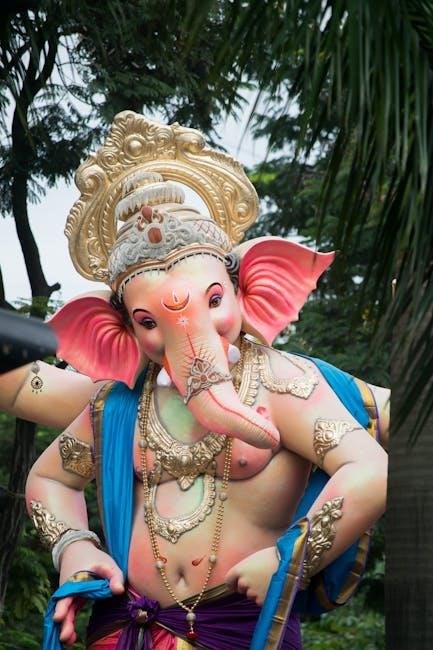
References
References include downloadable PDFs from GitHub‚ LitRes‚ and academic databases‚ providing comprehensive insights into William Golding’s Lord of the Flies and its underlying themes.
Key Sources for the Article
The article draws from various sources‚ including downloadable PDFs of Lord of the Flies from GitHub‚ LitRes‚ and academic databases. These sources provide insights into the novel’s themes‚ symbolism‚ and historical context. Specific documents like “Lord of the Flies.pdf” and “Philosophical parable of William Gerald Golding” offer detailed analyses. Additionally‚ study guides and online resources‚ such as those from LitRes‚ contribute to a comprehensive understanding of the novel. These sources ensure the article is well-researched and informative‚ offering readers a deep dive into Golding’s timeless classic.
Links to Downloadable PDFs
Multiple PDF versions of Lord of the Flies are available online for download. Platforms like GitHub and LitRes offer direct links to the novel in PDF format. Specific files‚ such as “Lord of the Flies.pdf” (1.9 MB) and study guides‚ can be accessed through these sources. Additionally‚ academic databases provide downloadable PDFs of analyses and essays on the novel. These links ensure easy access to the text and supplementary materials for readers and scholars alike‚ making it convenient to explore Golding’s masterpiece in depth.